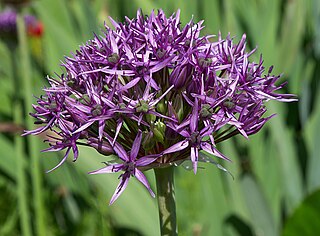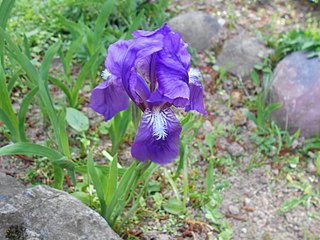
Pulsatilla pratensis, the small pasque flower, is a species of flowering plant in the family Ranunculaceae, native to central and eastern Europe, from southeast Norway and western Denmark south and east to Bulgaria. It grows from near sea level in the north of the range, up to 2,100 m (6,900 ft) in the south of its range.

Iris sibirica, commonly known as Siberian iris or Siberian flag, is a species of flowering plant in the family Iridaceae. It is a rhizomatous herbaceous perennial, from Europe and Central Asia. It has long green grass-like leaves, tall stem, 2–5 violet-blue, to blue, and occasionally white flowers. It is cultivated as an ornamental plant in temperate regions.

Senecio squalidus, known as Oxford ragwort, is a flowering plant in the daisy family Asteraceae. It is a yellow-flowered herbaceous plant, native to mountainous, rocky or volcanic areas, that has managed to find other homes on man-made and natural piles of rocks, war-ruined neighborhoods and even on stone walls. These habitats resemble its well drained natural rocky homeland. The plants have spread via the wind, rail and the activities of botanists. The travels of this short-lived perennial, biennial, or winter annual make it a good subject for studies of the evolution and ecology of flowering plants.

Iris spuria, or blue flag, is a species of the genus Iris, part of the subgenus Limniris and the series Spuriae. It is a rhizomatous perennial plant, from Europe, Asia and Africa. It has purple or lilac flowers, and slender, elongated leaves. It is widely cultivated as an ornamental plant in temperate regions and hybridized for use in the garden. It has several subspecies; Iris spuria subsp. carthaliniae B.Mathew, Iris spuria subsp. demetrii B.Mathew, Iris spuria subsp. maritima (Dykes) P.Fourn. and Iris spuria subsp. musulmanica (Fomin) Takht. It used to have 3 other subspecies, which have now been re-classified as separate species; Iris spuria subsp. halophila, Iris spuria ssp. sogdiana and Iris spuria subsp. notha . It has many common names including 'blue iris', 'spurious iris' and 'bastard iris'.

Allium atropurpureum is a plant species native to Hungary, the Balkans, and Turkey. It is widely grown as an ornamental for its rich, deep purple flowers.

Iris variegata, commonly known as the Hungarian iris, is a plant species in the genus Iris, also in the subgenus Iris. It is a rhizomatous perennial from eastern Europe. It has dark green, ribbed leaves. The branched flowering stems can be as tall as the leaves, they can hold 2–3 flowers in summer. They are yellowish-white, with brown-purple veins on the drooping falls. It is very hardy and it is commonly cultivated as an ornamental plant in temperate regions. There are several cultivars.

Subgenus Iris is one subgenus of Iris.

Iris ruthenica, sometimes called ever blooming iris, Russian iris, pilgrim iris and Hungarian iris, is a species in the genus Iris- subgenus Limniris. It is a rhizomatous perennial, with a wide distribution, ranging from eastern Europe to Central Asia. It has grass-like leaves, thick stem and violet or bluish lavender flowers which are marked with violet veining.

Iris pontica is a species in the genus Iris, it is also in the subgenus Limniris and in series Spuriae. It is a dwarf rhizomatous perennial plant from eastern Europe, the Causcasus region and Russia, with a short stem and violet-blue and white flowers. It is cultivated as an ornamental plant in temperate regions.
Iris xanthospuria is a species in the genus Iris, it is also in the subgenus Limniris and in the series Spuriae. It is a rhizomatous perennial plant, from Turkey with yellow flowers. It was originally known as 'Turkey yellow'. It is cultivated as an ornamental plant in temperate regions.

Iris spuria subsp. carthaliniae is a species in the genus Iris. It is also in the subgenus of Limniris and in the series Spuriae. It is a subspecies of Iris spuria, a rhizomatous perennial plant, from the Caucasus region, it is a tall iris with sky blue or white flowers. It was originally described by Fomin, as a separate species before Brian Mathew in 1981, added it to Iris spuria as one of its many subspecies. It is cultivated as an ornamental plant in temperate regions.
Iris spuria subsp. musulmanica is a species of the genus Iris, part of a subgenus known as Limniris and in the series Spuriae. It is a subspecies of Iris spuria and is a rhizomatous perennial plant, from Armenia, Azerbaijan, Iran and Turkey in Asia with flowers in various shades of blue, but there are rare white forms. They have a yellow centre and darker veining. It has the common name of 'Muslim iris'. It is cultivated as an ornamental plant in temperate regions.
Iris bloudowii is a species in the genus Iris. It is also in the subgenus of Iris and in the Psammiris section. It is a rhizomatous perennial, from Russia, Siberia, Kazakhstan, Mongolia and China, with sickle-shaped leaves, slender stem and 2 bright or pale yellow flowers. It is cultivated as an ornamental plant in temperate regions.

Iris humilis is a plant species in the genus Iris. It is also in the subgenus of Iris and in the Psammiris section. It is a rhizomatous perennial, with a wide distribution range from Europe to Russia to China, via Mongolia and Kazakhstan. It has sword-shaped leaves, a short stem and yellow flowers with an orange beard. It is cultivated as an ornamental plant in temperate regions.
Iris mandshurica is a species in the genus Iris; it is also in the subgenus of Iris and in the Psammiris section. It is a rhizomatous perennial, it is found in Russia, China, and Korea. It has green sword-like leaves, smooth green stem and yellow flowers, with yellow-purple veining and a yellow beard. It is cultivated as an ornamental plant in temperate regions.

Iris vorobievii is a plant species in the genus Iris, it is also in the subgenus of Iris and in the Psammiris section. It is a rhizomatous perennial, from Russia close to the Chinese border. It has long and thin green leaves, similar sized stem and pale yellow or bright yellow flowers with a pale yellow beard. It is cultivated as an ornamental plant in temperate regions.

Iris aphylla is a species in the genus Iris, it is also in the subgenus Iris, and in the section Iris. It is a rhizomatous perennial, from Asia to Europe. It is found in Azerbaijan, Russian Federation, Czech Republic, Germany, Hungary, Poland, Belarus, Ukraine, Bulgaria, Albania, Former Yugoslavia, Italy, Romania and France. It has dark green or bright green, sword-shaped, long grass-like leaves, that die/fade away in the winter. It also has a slender stem, with several branches and green and purplish spathes. It has 3–5 large flowers, in shades of bright purple, purple, violet, dark blue, blue-violet and dark violet, which bloom between spring and early summer. Occasionally, they re-bloom in the autumn, before the seed capsule is formed. It is cultivated as an ornamental plant in temperate regions. There is one known subspecies Iris aphylla subsp. hungarica Hegi.

Iris aphylla subsp. hungarica is a plant subspecies in the genus Iris, it is also in the subgenus Iris. It is a subspecies of Iris aphylla. It is a rhizomatous perennial, from the Carpathian Mountains and Pannonian Basin. Found within the countries of Romania, Hungary, Slovakia, Ukraine, Moldova, and Italy. It has curved, pointed, thin leaves, slender stem, several large flowers in shades of purple, or dark purple, or violet-blue. It is a rare plant, that is protected by environmental law in the various countries of Europe.

Iris subbiflora is a plant species in the genus Iris, it is also in the subgenus Iris. It is a rhizomatous perennial, from Portugal and Spain in Europe. It has evergreen broad leaves, forming dense clumps, it has dwarf stems in late spring,, with 1 upright fragrant flower, in shades of purple, light red purple, grey-blue, blue-violet, or dark violet. It has a beard which is generally blue, purple, or violet, but can fade to white, dull yellow, or dark yellow. After being found in 1804, it was once a separate species until the late 70s, when it was reclassified as subspecies of Iris lutescens, and renamed Iris lutescens subsp. subbiflora. But in the 80s it was returned to an independent species but some authors and references still class the species as a synonym or subspecies. It is cultivated as an ornamental plant in temperate regions.

Iris acutiloba subsp. lineolata is a species in the genus Iris, it is also in the subgenus of Iris. It is a subspecies of Iris acutiloba, and is a rhizomatous perennial, from the mountains of Iran, Turkey, Turkmenistan, Tajikistan and Azerbaijan. It has narrow, lanceolate, or falcate (sickle-shaped) leaves, which are grey-green and glaucous. It has a slender straight stem holding one terminal flower. The flowers, come in shades of white, cream, or creamy white and have veining that is purple or brown, or a mixture of both. It is heavily veined or streaked in purple or brown, with a dark purple-brown, spot on 3 of the outer petals and brown, dark purple, or black short beard. It is rarely cultivated as an ornamental plant in temperate regions, unless grown in a greenhouse.


















